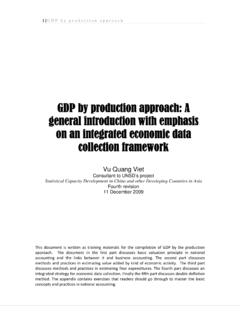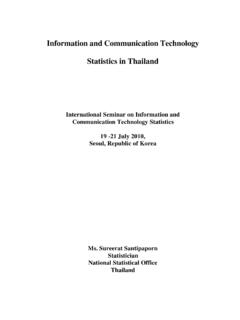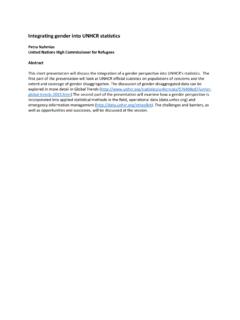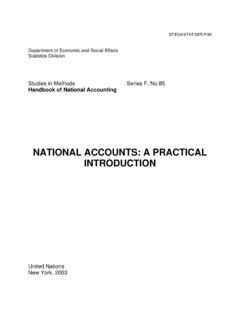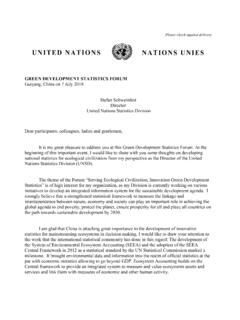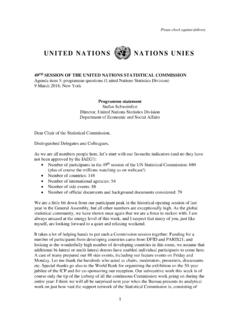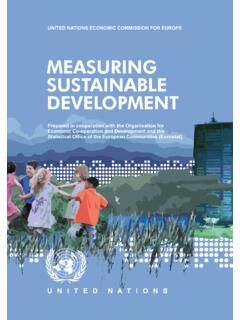Transcription of GDP by final expenditure approach ver1 - United Nations
1 GDP by final expenditure approach An operational guide for using commodity flow approach Vu Quang Viet Consultant to UNSD s project Statistical Capacity Development in China and other Developing Countries in Asia 26 May 2011 This document is written as training materials for the compilation of GDP by final expenditure approach . The first part of the document discusses basic concepts and methods for deriving main components of final expenditures such as final consumption, gross capital formation, exports and imports. The second part introduces the commodity flow approach for balancing use and supply of products in order to confirm the estimation as well as to estimate the expenditure components when limited information is available. 2 Table of Contents Introduction and workshop PART I. Measurement of final A. final consumption 1.
2 Household final consumption 2. Government final consumption 3. final consumption expenditure of 4. Transactions in second-hand B. Gross capital 1. Gross fixed capital 2. Changes in 3. Acquisition less disposals of 4. Capitalization of own-account 5. Relationship between supply, uses and gross capital C. Estimation of consumption of fixed D. Exports and imports of goods and services ..32 1. 2. Residents and 3. Valuation of exports and 4. Conversion of imports to imports 5. Estimation of exports and 6. Deflation of exports and PART II. An operational guide for using commodity flow approach to compile A. Valuation in national accounting ..39 1. Basic definitions: basic price, producer s price, purchaser s price, trade and transport margins ..39 3 2. Examples to illustrate valuation methods in the circulation of goods and services ..40 B. Supply and use tables.
3 44 1. Description of the supply and use tables ..44 2. Use of the supply and use tables to estimate national accounts 3. final expenditure approach to Data Balancing commodity supply and use at detail Problems linking COICOP and Balancing commodity supply and use as a short-cut Retail trade turnover C. Estimation of trade and transport 1. Through measurement of output of wholesaling, retailing and freight 2. Through indirect measurement of composite 3. Measurement of transport margins and taxes on D. Summary on commodity flow 67 Appendix1. Consumer expenditure survey in the United States of 4 Introduction and workshop recommendations 1. This document is written as training materials for the compilation of Gross Domestic Product by final expenditure approach (GDE). It is a follow-up to another document GDP by production approach .
4 GDP by production approach : A general introduction with emphasis on an integrated economic data collection framework 1that focuses on the analysis of production capability and results of production by economic activities. This document elaborates in more details the compilation of final expenditures that make up GDP such as final consumption of households, general government and non-profit institutional serving households (NPISHs), investment in fixed assets (gross capital formation) and net exports. These data are necessary for the analysis of the behaviour of economic institutional sectors of the economy in their consumption and investment decisions. 2. The document is based on the papers presented at the International Workshop on Measuring GDP by final demand approach held in Shenzhen, China between 25 and 27 April 2011.
5 The Workshop was sponsored by China s National Bureau of Statistics and the United Nations Statistics Division (UNSD) as part of the project Statistical Capacity Development in China and other Developing Countries in Asia. 3. The first part discusses the conceptual foundation and the methods for directly compiling every component of final expenditure . The second part discusses the commodity flow approach to balance supply and uses of commodity in order to ascertain final expenditure that is compiled independently or to derive data that are not available. 4. This workshop was part of a series of events organized under the project on strengthening statistical capacity development in China and other developing countries in Asia, funded by the Chinese Government. It was organized in two parts international and domestic. The workshop brought together over 90 experts from 16 countries in Asia - Cambodia, China, Hong Kong, India, Indonesia, Korea, Laos, Macao, Malaysia, Mongolia, Myanmar, Nepal, Philippines, Sri Lanka, Thailand and Vietnam as well as Canada, with different experiences, circumstances and needs.
6 The domestic part of the workshop was organized particularly for the Chinese participants from the National Bureau of Statistics and some of the provincial offices to discuss China s practice in compiling GDP by final demand approach and the reasons for the inconsistencies between the national GDP measured from the production and expenditure sides. 5. Mr. Frederick Ho (Hong Kong), Mr. Arthur Berger (Canada), Mr. Vu Q. Viet (UNSD consultant) and Mrs. Youlia Antonova (UNSD) served as resource persons. 1 5 Report and Recommendations of Workshop 1. Measurement of GDP by final demand approach independently rather as a residual. 6. National Statistical Offices were encouraged to measure independently GDP by final expenditure , and to reduce to the minimum possible the measurement of individual expenditure category as a residual between GDP (production) and GDE ( expenditure ).
7 2. More focus on direct measurement of inventories 7. Particularly important is the independent measurement of changes in inventories. Ratios of inventories over outputs provide important information on the short-term development of the economy. It is also important that inventories be prepared separately for materials and supplies which are used to compute intermediate consumption; work-in-progress and finished goods which are used to compute gross Some countries that participated in this workshop, unfortunately, still treat changes in inventories as residuals, which include statistical errors. Estimation of output from sales an example Calculating operations T0 T1 T2 T3 Information given 1. Sales net of taxes and plus subsidies 80 120 272 2. Price index 100 125 200 3. Value of inventory at end of period (book value) 0 40 30 16 4.
8 Change in inventory (book value) = (Ti Ti-1) applied to line (3) 40 -10 -14 Derived data 5. Value of inventory at constant prices = Line (3)*100/ line (2) 0 40 24 8 6. Change in inventory at constant prices = (Ti Ti-1) from line (5) 40 -16 -16 7. Change in inventory at current prices = Line (6) * line (2)/100 40 -20 -32 8. Output at basic price = Line (1) + line (7) 120 100 240 8. The proper revaluation of inventories at market prices to replace book values as practiced in business accounting is important in correctly measuring inventories and output. The approach to calculate non-farm inventories (on which data on quantity of inventories are not available) as practiced in Canada is recommended. The table above shows an example of revaluing inventories and calculation of output from sales. 3. Use of commodity flow approach recommended 9.
9 The workshop strongly supported the use of commodity flow approach as a systematic and consistent frame for the estimation of GDE. It is a simple form of supply and use tables (SUT), applicable in cases when national accountants do not have full set of data. The approach is based on using the benchmark SUT when it is available; when benchmark SUT is not available, simple ratios based on limited surveys or expert opinions may be used instead. 6 10. Due to cost constraint and time requirement to process data, detailed SUT is normally prepared for benchmark years only. In between them, an extrapolation by ratios from the base year to the current year should be applied to measure wholesale and retail trade margins, transport margins and taxes on products. The following allocation rules are recommended: a. Trade and transport margins: Normally margin on a given product is allocated proportionally to the values of products used; b.
10 Taxes on products: Taxes are distributed proportionally to the values consumed, excluding consumption categories that are either not subject to taxes or subject to tax deduction; c. Allocation rules for supply of other goods and services destined to final expenditures: i. The following information are required and normally available: Industry output in basic prices Product price indexes (producers price indexes, consumer price indexes, import price indexes and export price indexes Data on exports and imports Preliminary data on general government FCE and GCF Limited information on household FCE ii. The following needs to be done: Convert industry output to product output in purchasers prices Deflate product output Estimate trade and transport margins in constant prices Estimate products consumed as intermediate inputs in constant prices Estimate total products that can be used for GCF and household FCE in constant prices and then reconvert them back to current prices.)
